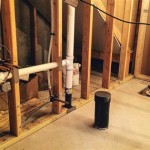Installing an Egress Window in a Basement Wall: A Comprehensive Guide
Egress windows serve as vital safety features in basements, providing a means of escape in the event of a fire or other emergency. Beyond safety, they also allow natural light and ventilation into what often are dark and confined spaces, potentially transforming a basement into a more habitable and inviting living area. Installing an egress window in a basement wall is a significant undertaking that requires careful planning, adherence to local building codes, and often, professional expertise. This article provides a comprehensive guide to the process.
The installation process is not merely about cutting a hole in the wall and inserting a window. It involves structural considerations, waterproofing, drainage, and ensuring the window meets specific size and operational requirements mandated by building codes. Failing to meet these requirements can result in failed inspections, potential safety hazards, and difficulty selling the property in the future.
Before commencing any work, it is crucial to thoroughly research and understand local building codes pertaining to egress windows. These codes dictate the minimum size of the window opening, sill height, and the ease of operation for emergency egress. These regulations vary by jurisdiction, so consulting with a local building inspector or a qualified contractor is highly recommended.
Several factors influence the complexity and cost of the egress window installation. These include the type of basement wall (poured concrete, concrete block, or stone), the depth of the window well required (depending on the depth of the basement), and the soil conditions surrounding the foundation. Each of these elements presents unique challenges that must be addressed during the installation process.
The following sections will detail the key aspects of installing an egress window in a basement wall, from planning and preparation to the actual installation and finishing.
Planning and Preparation
The first step in the process is meticulous planning. This includes selecting the appropriate location for the egress window, obtaining necessary permits, and gathering the required tools and materials. The location of the window should ideally be easily accessible from within the basement and provide a direct path to the outside without obstructions.
Obtaining the correct permits is essential. Building codes require permits for structural alterations, and installing an egress window falls squarely into this category. Applying for and receiving a permit ensures that the installation will be inspected and meet all safety and structural requirements. Failure to obtain a permit can result in fines, delays, and the potential for having to redo the work at considerable expense.
The selection of the appropriate egress window and window well is also crucial. Egress windows are available in several styles, including casement, sliding, and awning windows. The chosen style must meet the minimum opening size requirements while also being easy to operate from inside the basement. The window well, a structure that surrounds the window outside the basement, must be deep enough to allow for adequate egress and should also include a drainage system to prevent water buildup.
Finally, gathering the necessary tools and materials is critical for a smooth and efficient installation. These include safety glasses, gloves, a dust mask, a concrete saw or jackhammer, a sledgehammer, chisels, a level, a measuring tape, concrete mix, waterproofing sealant, gravel, and the window and window well components. Depending on the complexity of the project, hiring specialized equipment such as a concrete cutting saw may be necessary.
The Installation Process
The actual installation of the egress window involves several stages, each requiring precision and attention to detail. The initial step is to carefully mark the outline of the window opening on the interior basement wall. This outline should be based on the dimensions of the window and the requirements for the rough opening. Safety is paramount during this stage; wear appropriate safety gear, including eye protection and a dust mask.
Cutting the opening in the basement wall is typically done using a concrete saw or a jackhammer. A concrete saw provides a cleaner and more precise cut, but it may require multiple passes, especially for thicker walls. A jackhammer is faster but can be less precise and may require more cleanup. Regardless of the method used, exercise caution to avoid damaging the surrounding structure.
Once the opening is cut, the rough edges need to be smoothed and prepared to receive the window frame. This often involves using a chisel and hammer to remove any loose concrete and create a level and even surface. Clean the opening thoroughly to remove any dust and debris.
The next step is to install the window frame. The frame should be carefully positioned in the opening and secured using shims to ensure it is level and plumb. Once the frame is properly aligned, it can be fastened to the concrete wall using concrete screws or expanding foam. It is imperative that the frame is securely attached to the wall to prevent leaks and ensure the structural integrity of the window.
Before installing the window itself, apply a generous amount of waterproofing sealant around the perimeter of the frame. This sealant will create a watertight barrier and prevent water from seeping into the basement. Install the window according to the manufacturer's instructions, ensuring it is properly sealed and operable.
Outside the basement, the window well needs to be installed. Dig a hole around the window opening that is large enough to accommodate the window well structure. The depth of the hole should be sufficient to allow for proper egress and should also include a layer of gravel at the bottom for drainage. Install the window well according to the manufacturer's instructions, ensuring it is securely attached to the foundation wall. Backfill around the window well with gravel to promote drainage and prevent water buildup.
Addressing Key Considerations and Best Practices
Throughout the installation process, several key considerations must be addressed to ensure a successful and long-lasting outcome. These include proper waterproofing, drainage, and structural support.
Waterproofing is crucial to prevent water from entering the basement through the window opening. Apply a high-quality waterproofing sealant around the perimeter of the window frame, both inside and outside the basement. Additionally, consider applying a waterproofing membrane to the exterior foundation wall around the window opening. This membrane will provide an extra layer of protection against water penetration.
Proper drainage is also essential to prevent water from accumulating in the window well. Install a layer of gravel at the bottom of the window well to promote drainage. If the soil around the foundation is not well-draining, consider installing a drainage pipe that connects the window well to a drainage system or a sump pump. This will ensure that water is effectively removed from the window well and prevent it from seeping into the basement.
Structural support may be necessary, especially for older homes with weaker foundation walls. If the wall is prone to cracking or crumbling, consider installing a lintel or header above the window opening to provide additional support. This will prevent the wall from collapsing and ensure the structural integrity of the window installation. Consult with a structural engineer to determine the appropriate type and size of lintel or header required.
Another best practice is to thoroughly inspect the installation after it is completed. Check for any gaps or cracks around the window frame and seal them with sealant. Ensure that the window operates smoothly and that the window well is properly drained. Monitor the installation for any signs of water leakage, especially after heavy rain. Address any issues promptly to prevent further damage.
Finally, consider the aesthetic aspects of the installation. Choose a window and window well that complements the style of the house. Landscape around the window well to enhance its appearance and make it more inviting. A well-designed egress window can not only improve the safety and functionality of the basement but also enhance the overall curb appeal of the property. Consider hiring a professional landscaper to assist with the landscaping aspects of the installation.

How To Install A Basement Egress Window Acculevel

Installing An Egress Window In Our Luxurious Basement Dwelling Bright Green Door

What Features Do I Need In A Basement Egress Window Aaa Foundation Repair Wichita

How To Install An Egress Window

How To Install An Egress Window With S Wikihow

Basement Egress Window Cost And Installing An

The Process Of Enlarging Basement Windows Twofeetfirst

Installing An Egress Window Well Ez Hang Door

Installing An Egress Window In Our Luxurious Basement Dwelling Bright Green Door

How To Install An Egress Window
See Also








